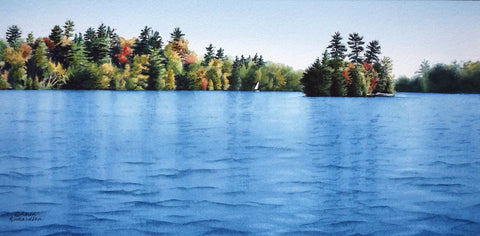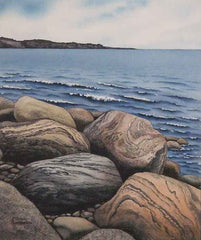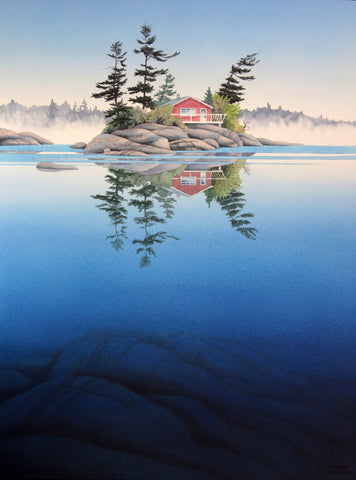
Northern lakes are the places in nature that heal the stress of my busy life, calm my mind, and restore my equilibrium. I love them beyond measure and cannot imagine a life that does not offer frequent immersion in these glorious landscapes throughout the year.
I pour my authentic soul into each and every painting I create of remarkable natural places. My hope is that you, the viewer, find a soothing resonance within your own true self when you gaze upon my artwork.
Every winter I enjoy several months of dedicated studio time. This post tells the creation stories of my latest northern lake paintings, all of which are small in size but abundant in optimism and joy.

Shown above is A Piece of Heaven, watercolour on panel (no glass) 6 x 12".
This piece was inspired by two photos taken years ago. I forget the locations but I think they were somewhere in Ontario. One was an early autumn photo and the other was was taken in summer, but they joined together to make an interesting composition (shown below).

I particularly liked the tiny sailboat near the island, and the faint reflections of the dark trees on choppy water. I decided to make my painting a later autumn scene. How lovely it would be to spend a breezy day sailing between the islands of this glorious place.
Click here for more details about A Piece of Heaven.

Shown above is Out of the Blue, watercolour on panel (no glass) 12 x 9". This piece is entirely from my imagination, based on years of visiting beautiful northern lakes and absorbing their peace and serenity.
I painted the sky and water first, building up a half dozen layers over the course of a week to get the depth of colour I needed. When that was fully dry I penciled in the island and two canoeists, then painted them. They are enjoying a peaceful paddle around the island, before the sun dissolves the early morning mist.
Click here for more details about Out of the Blue.

Shown above is Autumn Dream, watercolour on panel (no glass) 6 x 12". It is another piece painted entirely from my imagination. Originally it was a square 12 x 12" work in progress, but I overworked the reflections and decided to crop them out of the painting. I think this stretched format makes a stronger statement.
I especially love the clear autumn colours and variety of trees on the island, and the misty shores in the background. I included a canoe in the scene to add to the story. Someone is exploring this wee island. Maybe they camped here last night and are preparing for another glorious day on the lake.
Click here to see more details about Autumn Dream.

Shown above is Autumn Adventure, watercolour on panel (no glass) 8 x 8". I took the reference photo (pictured below) a few years ago on an ATV excursion in the Haliburton region of central Ontario.

It was easy to translate this photo into a square format. I changed the overcast day into a sunny one in my painting. I included the overhanging leaves to enhance the sense of shelter and protection. The viewer is exploring on a fine autumn day, peeking out from a tree-covered shoreline to discover this wee gem of an island. Let's hop in a kayak or canoe and paddle over there.
Click here for more details about Autumn Adventure.

Shown above is When All is Calm, watercolour on panel (no glass) 6 x 12". This scene was inspired by two photos I took somewhere in Ontario years ago (shown below).

I employed considerable artistic license when creating this painting. It captures a moment of serene calm - that rare early autumn day when the lake is like glass. We all could use some of this peace and solace these days.
Click here for more details about When All is Calm.

Shown above is The Golden Hour, watercolour on panel (no glass) 10 x 10". This is one of those paintings that started off as one thing and morphed into something completely different. It was like the painting knew what it wanted to be and nudged my brush strokes in that direction.
The original idea was inspired by two saltwater sunset photos (shown below) that I took near Twillingate when we visited Newfoundland last summer. I liked the golden tones in the first photo and planned to add the moored sailboat from the second photo. The story would involve sailors anchored for the night in a sheltered bay.


I decided on a square format and started painting the sky and its reflection. It took many layers over the course of a week to build up rich colour and contrast between the glow of the sun and the shadows surrounding it. Shown below are 3 stages of this layering process.



The resulting bronze colour scheme was not the original coppery hue from the photo reference, and the highlights were more globular than streaky, but I really liked the soft, soothing mood that was emerging. I looked through my photo archives for a new water scene reference and found the perfect one (shown below).

I took this early morning photo decades ago at the old Richardson family cottage on Big Cedar Lake in central Ontario. I used the iconic raft and far shore as references to complete my painting and the story became a quiet moment in cottage country.
Click here for more details about The Golden Hour.
I hope you have enjoyed this behind-the-scenes look at my latest creations, and a glimpse into how I translate photos from my travels into unique artistic expressions. My hope is that my artwork will welcome viewers like old friends, and draw them into the narrative deeply embedded in each painting.
If you have comments you wish to share, please do so using the 'Leave a Comment' button at the top of this post.
Subscribe to Karen's Newsletter for exclusive early access to new work, studio news updates, travel tales, painting tips, and notices of upcoming exhibitions.


























































































